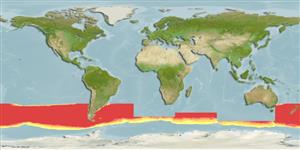Common names from other countries
>
Lampriformes (Velifers, tube-eyes and ribbonfishes) >
Lampridae (Opahs)
Etymology: Lampris: Greek, lampros = light (Ref. 45335).
Environment: milieu / climate zone / depth range / distribution range
Ekologi
marina; djupintervall 50 - 485 m. Temperate; 34°S - 69°S
Circumglobal in the southern hemisphere between 34°S and the Antarctic Polar Front.
Size / Vikt / Age
Maturity: Lm ? range ? - ? cm
Max length : 110 cm TL hane/ej könsbestämd; (Ref. 6475); publicerad maxvikt: 30.0 kg (Ref. )
Short description
Bestämningsnycklar | Morfologi | Morfometri
Taggstrålar i ryggfenan (totalt) : 0; Mjukstrålar i ryggfenan (totalt) : 55 - 56; Taggstrålar i analfenan: 0; Mjukstrålar i analfenan: 36 - 40.
Feeds on krill, squid and fishes.
Life cycle and mating behavior
Maturities | Reproduktion | Spawnings | Egg(s) | Fecundities | Larver
Gon, O., 1990. Lampridae. p. 215-217. In O. Gon and P.C. Heemstra (eds.) Fishes of the Southern Ocean. J.L.B. Smith Institute of Ichthyology, Grahamstown, South Africa. (Ref. 5188)
IUCN Red List Status (Ref. 130435)
CITES (Ref. 128078)
Not Evaluated
Threat to humans
Harmless
Human uses
Verktyg
Special reports
Download XML
Internet-källor
Estimates based on models
Preferred temperature (Ref.
115969): 1.8 - 11.9, mean 6.1 (based on 287 cells).
Phylogenetic diversity index (Ref.
82804): PD
50 = 1.0000 [Uniqueness, from 0.5 = low to 2.0 = high].
Bayesian length-weight: a=0.01995 (0.00906 - 0.04395), b=3.01 (2.83 - 3.19), in cm Total Length, based on all LWR estimates for this body shape (Ref.
93245).
Trofisk nivå (Ref.
69278): 4.4 ±0.70 se; based on food items.
Resiliens (Ref.
120179): Mellan, lägsta populationsfördubblingstid 1,4-4,4 år (Preliminary K or Fecundity.).
Fishing Vulnerability (Ref.
59153): High to very high vulnerability (66 of 100).
Climate Vulnerability (Ref.
125649): Moderate to high vulnerability (45 of 100).
